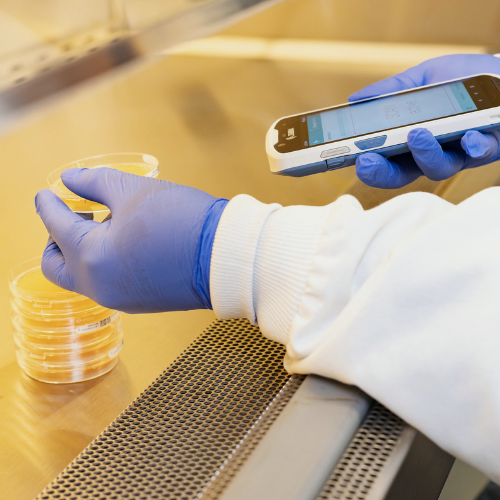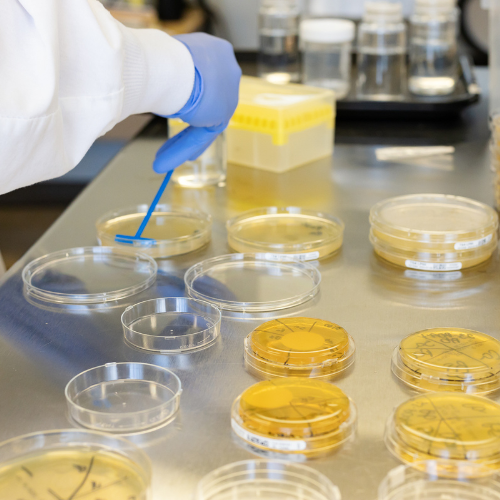Environmental Monitoring - The Basics:
White Paper
Cormica is a GMP & GLP accredited microbiology, analytical and physical testing laboratory group with deep experience supporting pharmaceutical & medical device manufacturers through robust environmental monitoring programs.
What is Environmental Monitoring and Why is it Important?

Environmental Monitoring (EVM) is a group of practices used to detect the levels of potential airborne or surface contaminants within a controlled environment. The practices should form part of an EVM programme which provides sufficient data to ensure the controlled environment is operating within an adequate state of control.
As per EudraLex Volume 4, Annex 1, it is ‘the minimum requirements and controls to produce medicinal products required to be sterile’. Failure to implement and maintain a robust EVM programme may result in inadvertent product contamination and regulatory warnings or restrictions.
EVM practices are typically organised into two groups: Viable Monitoring and Non-Viable Monitoring. Viable monitoring assesses the microbial bioburden, whereas non-viable monitoring assesses the total airborne particulate concentration for particle sizes >0.5µm to >5µm.
Media Types – Viable Air Monitoring
Viable monitoring requires the selection of appropriate media types.
Typically, the following media types are used for EVM in pharmaceutical settings:
- Tryptone Soya Agar (TSA) – A general, non-selective media typically used for the culture of bacterial species
- Sabouraud Dextrose Agar (SDA) or Malt Extract Agar (MEA) – A selective media for yeast and fungi
- Tryptone Lecithin and Tween 80 (TLT or TSA+) – A general, non-selective media with the addition of neutralisers which nullify any disinfectant residues.
These plates are typically used in a 55mm contact plate or 90mm Settle plate format.
Type:
Published:
Authors:

Theodora Wentworth
Theodora Wentworth leads Environmental Monitoring at Wickham Micro, with expertise in GMP compliance, contamination control, and Annex 1 guidance.

Paul Lutz
Paul Lutz is Director of Environmental Monitoring at Focus Labs, with 10+ years’ experience in pharmaceutical compliance, EMPQ, and microbial control strategies. He is a trusted advisor on risk management, trending, and regulatory audits.
Monitoring Types
Non-viable monitoring uses an airborne particle counter which draws in a volume of air. The air is subject to a photodetector laser beam which detects the change in light. The shadow created by the particles is analysed to determine the number and size of the particles, thus giving an indication to the levels of non-viable particulate matter per volume of air sampled. Particulate air monitors can be fixed or mobile depending on the nature of activities performed.
There are three basic methods used in viable monitoring: Settle Plates, Active Air Plates and Contact Plates.
Settle plates are a passive monitoring method whereby plates are left open in a risk-assessed position for a maximum of 4 hours. They are particularly useful positioned in high grade areas where sterile air is broken by operational activities.
Active Air plates are a viable monitoring method which uses an active air sampler to pass a known volume of air over an agar plate. This method produces a snapshot of the air within the room at the time the sample is taken. Whilst seen as a gold standard for monitoring, it is important to be aware of air sample manufacturing standards as per EN17141.
Contact plates are smaller, 55mm plates with a domed surface. They are used to assess the microbes present on a surface and should contain disinfectant neutralisers. Due to this neutralising action, they should also be used for finger & gown samples.
Monitoring Frequency
EVM programmes must use a risk-assessed approach to address the frequency of monitoring.
For Grade A environments, continuous monitoring must be performed. Commonly, this is achieved using settle plates however, recent advances in technology have allowed for continuous active air monitoring.
Routine monitoring of the cleanroom should be performed, with consideration to perform monitoring after the following activities:
- Post clean down to assess the efficacy of the clean.
- Post shutdown to ensure cleanroom performance remains suitable.


Alert and Action Limits
The microbial bioburden of the cleanroom should be assessed during the ‘At Rest’ and ‘In Operation’ qualification states. The action limit for these states can be seen in Annex 1, Table 2. The cleanroom should remain within these action limits.
A breach of action limits should be formally investigated, and the root cause identified.
Alert limits must be set upon review of the trending data and the results of the qualification. Pharmacopeial requirements (USP <1116>) state that the limits must be able to identify unfavourable trends. Alert limits can result in an investigation should multiple areas breach the alert limit, or if an adverse trend is observed. These limits should be reviewed annually.
EVM data trends must be reviewed for batch dispositioning.
Identification of Isolates
For Grade A and B areas, species level identification of all isolates must be performed.
For all other classified areas, the identification of isolates should be performed at regular intervals, and after specific events.
For Example:
- Post qualification to gain an understanding of the ‘normal’ cleanroom flora.
- After shutdown activities to ensure no contaminants have been introduced during the shutdown.
- Periodically, to detect negative trends of unfavourable organisms.
- When action limits have been exceeded to aid in identifying the cause of the contamination.
At Cormica we have multiple MALDI-ToF biotypers, MicroSEQ and VITEK’s that can identify organisms down to species level.
How Cormica Can Set You Up For Success
With over 60 years of experience, Cormica’s expert team delivers comprehensive environmental monitoring services. From cleanroom risk assessments and qualifications to routine monitoring and microbial isolate identification, we support every stage of your cleanroom compliance strategy.
If you are seeking to validate cleanroom performance or optimise your environmental monitoring plan, contact our specialists for a free consultation.
